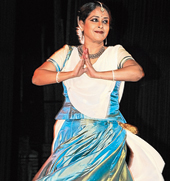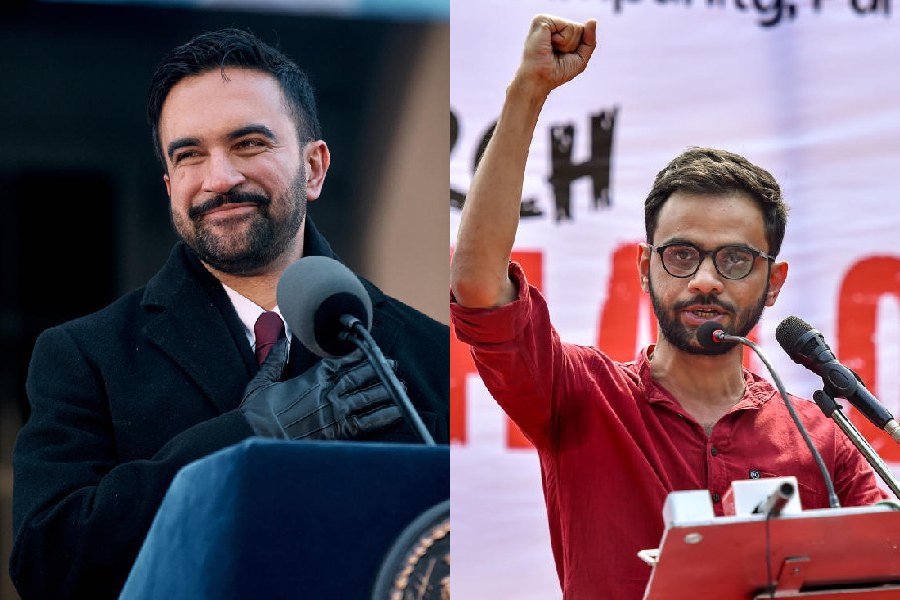 |
| Sharmistha Mukherjee dances to Tagore’s tunes at Rabindra Sadan on Tuesday evening. Picture by Aranya Sen |
She had famously pleaded with her finance minister father to levy a “very special tax” on friends refusing to have dinner cooked by her.
But kathak danseuse Sharmistha Mukherjee’s tribute to Rabindranath Tagore on Tuesday was all about getting her Calcutta audience to connect with her craft without looking at her as a famous father’s daughter.
In town with her latest dance production Anandadhara as part of the bard’s 150th birth anniversary celebrations, Pranab Mukherjee’s daughter performed to the tunes of Tagore at Rabindra Sadan.
Mother Suvra Mukherjee was to take the stage next, the lead vocals to Ritu Ranga, a song-and-dance medley on Tagore’s works directed by her. But that was not to be. “I haven’t been keeping well and my voice was in a bad state so I didn’t sing today,” said Pranab Mukherjee’s wife, who watched her daughter’s dance from the front row with Meera Bhattacharjee, wife of the Bengal CM, by her side.
Sharmistha, in her late thirties, who has long “rejected” politics for dance, is glad people are finally seeing her as a danseuse who happens to be Pranab Mukherjee’s daughter rather than the other way round.
 |
| Sharmistha Mukherjee |
The finance minister wasn’t present at Rabindra Sadan, but he does make time to attend some of Sharmistha’s programmes.“He watched Anandadhara when it premiered in Delhi. I think he understood it better as it had Tagore. Otherwise, it goes over his head,” chuckled the daughter.
“I grew up on Tagore’s literature, but working with a group of artistes who are mostly non-Bengali was an interesting and challenging experience,” said Sharmistha, who trained under the late Pandit Durgalal, Uma Sharma and Rajendra Gangani in Delhi.
But why do she and mother Suvra perform separate pieces? “My mother hasn’t been keeping well for nearly 10 years. To have her sing for my kathak piece would have meant lots of rehearsals, the strain of which she wouldn’t have been able to take.... Plus, onek jhogra-o hoto (there would have been a lot of fights), like all mothers and daughters,” smiled Sharmistha.
Although Sharmistha likes to remain true to the classical style, she isn’t averse to innovations like kathak blended with classical Arabic poetry or western classical music like Bach’s Brandenburg Concertos, especially when performing abroad.
“Like they say, jangal mein mor naacha kaun dekha (who saw the peacock dance in the forest)? Classical dance forms don’t get due attention. It’s very important for the younger generation to read, watch and revisit these works…. Experiments will help create a new audience.”
Sharmistha credits her mother with getting her interested in the arts, although her father has also been “very liberal in giving us (she and her two brothers) the freedom to pursue our interests”.
She has consciously avoided state patronage, making an exception to accompany former president A.P.J. Abdul Kalam to Iceland on a state visit in 2005 to perform Indian classical dance.
“I have tried to keep myself away from all this. I have never accepted a grant because I don’t want to get into a controversy. I know that people are likely to say that she’s so and so’s daughter, so it comes easy,” rued Sharmistha, who had written a humour-laced open letter to her father last year stating her budget wish list.
“It (the family name) becomes a hindrance more than an advantage at times, but fair enough. Each profession has its hazards,” she signed off.











